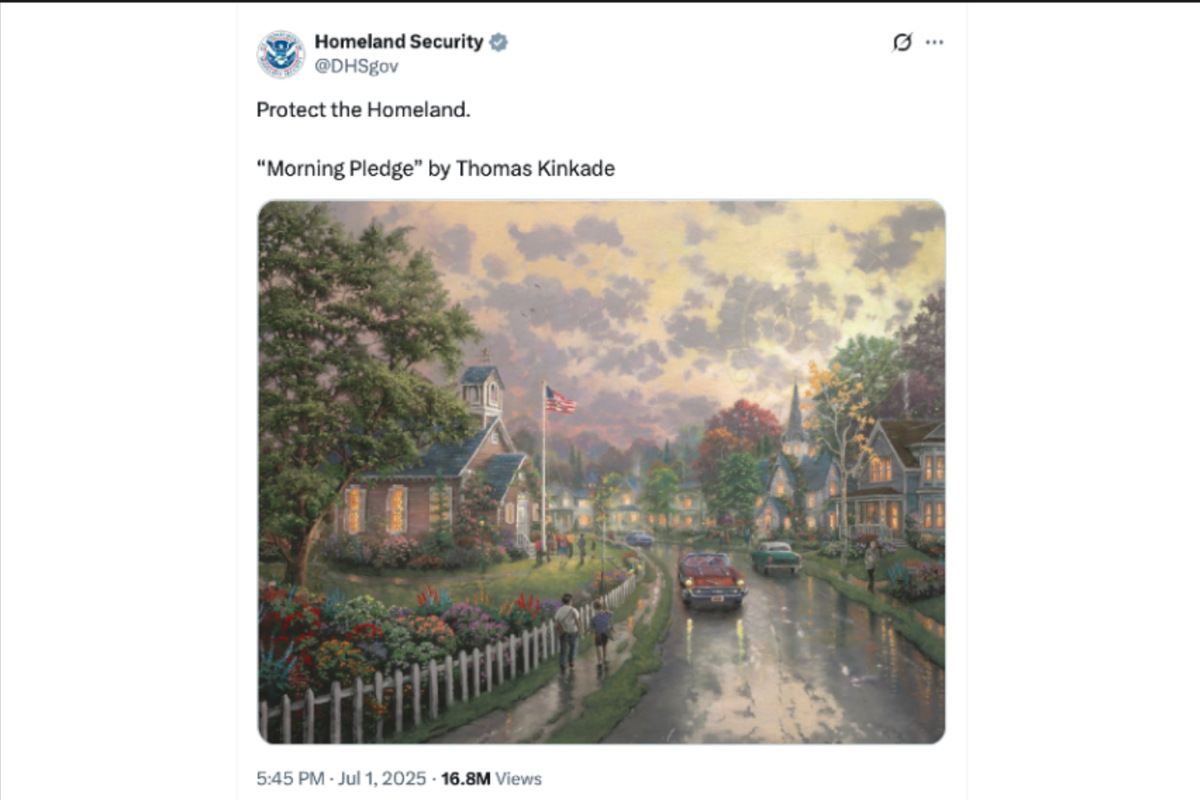Immigration officials used late artist Thomas Kinkade’s painting in a social media post pushing the Trump administration’s anti-immigration agenda — a move that the painter’s family “strongly condemns.”
President Donald Trump vowed to execute “the largest deportation program in American history” and his administration has set a goal to remove 1 million undocumented immigrants each year. Now, his Department of Homeland Security is amplifying his anti-immigration agenda by sharing American painters’ works that honor the country’s history.
“Protect the Homeland,” the department wrote in a social media post on July 1, alongside a photo of Kinkade’s “Morning Glory” painting that depicts children on their way to a quaint schoolhouse with an American flag flying next to it. The artist died in 2012, but his family now says they are “deeply troubled” by the use of the artwork.
That prompted the family to release its own statement to blast the use of his artwork.
“We strongly condemn the sentiment expressed in the post and the deplorable actions that DHS continues to carry out. Like many of you, we were deeply troubled to see this image used to promote division and xenophobia associated with the ideals of DHS, as this is antithetical to our mission,” the Kinkade Family Foundation wrote in a statement on its website.
The use of this painting was “unauthorized,” the foundation said, noting it has requested that DHS remove the post.

“We stand firmly with our communities who have been threatened and targeted by DHS, especially our immigrant, BIPOC, undocumented, LGBTQ+, and disabled relatives and neighbors.”
Kinkade, born in California in 1938, was known for his idyllic landscape paintings and use of light and vibrant colors in his works. Many of his paintings featured scenes of quintessential American life, with some capturing nationally recognized landmarks such as the Golden Gate Bridge or Times Square, while others illustrated quaint countryside scenes, namely cottages dotted by radiant flowers.
Although he was dubbed the “Painter of Light,” he endured dark periods in his life. He had a rough upbringing rocked by financial instability and later suffered from substance abuse issues, which ultimately led to his sudden death at just 54 years old in 2012, leaving behind his four daughters.
A DHS spokesperson Tricia McLaughlin told the Washington Post that the agency was paying tribute to artwork that “celebrates America’s heritage and history.”
“If the media needs a history lesson on the brave men and women who blazed the trails and forged this republic from the sweat of their brow, we are happy to send them a history textbook,” she told the paper. “This administration is unapologetically proud of American history and American heritage.”
It’s not immediately clear if the DHS plans to take down the post. As of Wednesday morning, the post is still on X. The Independent has reached out to the DHS for more information about whether it plans to take down the post.
According to a statement from Thomas Kinkade Studios about the painting, the artist “absolutely knew that the United States was a beacon of hope for the world, promising fundamental justice and dignity for all those living here and help for those not allowed their basic human rights no matter where they might be.”

Kinkade’s painting is one of several works of art that the department has shared on its social media in the past few weeks alongside anti-immigration messages.
On July 14, the department shared Morgan Weistling’s “A Prayer for a New Life” — but mistitled it — and attached the message: “Remember your Homeland’s Heritage.”
On July 23, the agency posted John Gast’s “American Progress” painting alongside the caption: “A Heritage to be proud of, a Homeland worth Defending.”
In response to the Washington Post’s article about the DHS’s pattern of posting the paintings, the agency addressed the publication directly — and posted Edward Percy Moran’s “The Birth of Old Glory” painting.
“Dear @washingtonpost, add this one to your story. This administration is unapologetically proud of American history and American heritage. Get used to it,” the agency wrote.






